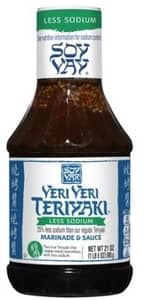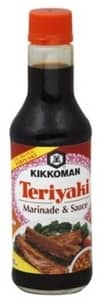Teriyaki sauce is a popular condiment best described as a thickened, sweeter version of soy sauce used for grilling and other applications. Ingredients can range quite a bit and chefs tend to have their own variations.1
Is it vegan? Yes, Teriyaki sauce is considered vegan. Commercial teriyaki sauce tends to contain soy sauce (water and soybeans, etc.), a sugar source (HFCS, table sugar, etc.), vinegar, salt, spices, and a few preservatives (e.g. sodium benzoate)—all of which are vegan.
While sugar itself can be considered non-vegan (i.e. if bone char is used for its production), products containing sugar aren’t considered unsuitable for vegans, at least by most standards.6
As far as teriyaki sauce in restaurants, chefs tend to have their own recipes, but such variations usually contain the ingredients mentioned above.
Why Teriyaki Sauce Is Considered Vegan
Teriyaki Sauce Doesn’t Contain Fish
This is a huge one. Fish sauce, of course, contains fish.2,3 Worcestershire sauce tends to contain anchovies.4
Teriyaki sauce, while similar in appearance, lacks any sort of juice derived from animals. Instead, it uses soy sauce as a base.1
Sugar Doesn’t Render a Food Product Non-Vegan By Most Standards
Teriyaki is a cooking method and teriyaki sauce is a condiment used when employing the cooking method to prepare meats, etc.
The noun “teri” (or 照り) in “teriyaki” refers to the luster and shine produced by the sugar content in the tare. Tare is just a name for Japanese dipping sauces, one of which being teriyaki sauce.
The “yaki” (or 焼き), refers to the cooking methods (grilling or broiling) used to prepare dishes commonly made with teriyaki sauce.5
Teriyaki sauce and other tare sauces are known for their sweet taste. The sweetness is usually derived from sugar or high fructose corn syrup (HFCS).
Some vegans tend to view sugar as a red flag because a lot of sugar tends to be processed with bone char. However, not all sugar is processed with bone char, and most vegans don’t avoid consuming sugar, because it’s nigh impossible to know how sugar was derived in any given food product.
PETA says it best. In their article, Is Sugar Vegan? They state “Don’t stress too hard about sugar if you’re unsure about how it was produced.”6
They go on to explain how you’re saving 100+ animals per year by following a vegan diet and lifestyle, and that the snowball effect you’ll have on the people around you, will help inspire others to try the vegan diet.6
I personally don’t know any vegans who actively avoid sugar-containing food products. That’s not to say that the use of bone char in processing sugar isn’t problematic. And, if you’re going to buy sugar at a grocery store, it would be best to go with the organic variety because it’s less processed overall and tends not to use bone char.
Non-Vegan Applications of Teriyaki Sauce
Just because a food product in itself is considered vegan, doesn’t mean every application of the product is suitable for vegan consumption.
Teriyaki sauce is a great example of a vegan food used for non-vegan purposes. Because, again, the term “teriyaki” is actually a technique used in cooking Japanese cuisine in which foods are grilled or broiled with a glaze of teriyaki sauce (i.e. soy sauce, sugar, and mirin).7,8
Teriyaki Fish
Fish like marlin, yellowtail, skipjack tuna, trout, salmon, and mackerel tend to be served with teriyaki sauce in Japan. Squid, meatballs, and hamburger steak are also commonly prepared with teriyaki sauce in this region.9
Meat (Steaks, Teriyaki Burgers, Etc.)
Red and white meat like beef, lamb, pork, and chicken are more often prepared with teriyaki sauce in the West.9
Again, the “yaki” in teriyaki refers to the cooking methods used to prepare meat. The meat is traditionally brushed or dipped in the sauce several times throughout the cooking process.10
The sauce is boiled/evaporated to achieve its desired thickness, at which point it’s used to marinate meat, which is then broiled or grilled.
In North America, any type of dish made with a tare sauce (typically teriyaki sauce) is described as teriyaki.
The specific formulations used for cooking meats are often sweet, though they can also be spicy. Pineapple juice is fairly common because it has enzymes that help break down the meat.
Non-traditional methods of preparing meat with teriyaki sauce involve grilling the meat first and then pouring the sauce on or just using the sauce as a marinade.7
Teriyaki sauce also tends to be used on chicken wings, by either spreading it on while cooking the meat or using it as a dipping sauce.
Teriyaki burgers are also fairly common. The burgers either have the sauce worked into the ground beef or have it spread on top.
Then there’s teriyaki stir-fry which is the stir-frying of meat and vegetables with the sauce added into the mixture.
Honey: The Non-Vegan Ingredient Potentially Present in Teriyaki Sauce
Tare sauces, including teriyaki, always have some sweet substance in the mix. The substance is often sugar but can be honey.
For example, Kikkoman Original Teriyaki Takumi Sauce contains:11
- Soy Sauce (Water, Wheat, Soybeans, Salt)
- Sugar
- Brown Sugar
- Granulated Garlic
- Ginger Puree (Ginger, Water)
- Honey
- Sesame Oil
- Sesame Seeds
- Dehydrated Onion
- Salt
- Lemon Juice Concentrate
- Yeast Extract
- Xanthan Gum
Unlike sugar, honey is definitely considered a no-go for vegans. Neither the American Vegan Society or the Vegan Society considers honey to be suitable for vegans.12
Commercial Vegan Teriyaki Sauces
They’re basically all vegan. But, I’ll list a few common sauces that are known to be suitable for vegans, just so you’ll have an idea of what’s out there.
Soy Vay Veri Veri Teriyaki Less Sodium Marinade & Sauce

Ingredients include:13
- Soy Sauce (Water, Wheat, Soybeans, Salt)
- Sugar
- Water
- Expeller Pressed Vegetable Oil (Soybean and/or Canola)
- Dried Onion
- Sesame Seeds
- Dried Garlic
- Vinegar
- Ginger puree (Ginger, Water)
- Expeller Pressed Sesame Oil
- Dried Ginger
Kikkoman Teriyaki Marinade & Sauce

Ingredients include:14
- Soy Sauce (Water, Wheat, Soybeans, Salt)
- Wine
- High Fructose Corn Syrup
- Vinegar
- Salt
- Spices
- Onion Powder
- Succinic Acid
- Garlic Powder
- Sodium Benzoate (Less than 1/10 of 1% as a Preservative)
Mr. Yoshida’s Sweet Teriyaki Marinade & Cooking Sauce

Ingredients include:15
- Soy Sauce (Water, Wheat, Soybeans, Salt)
- Sugar
- High Fructose Corn Syrup
- Yoshida’s Mirin—Water, Dextrose, Mirin (Rice, Alcohol, Enzymes, Salt)
- Lactic Acid*
- Succinic Acid
- Water
- Dehydrated Garlic
- Spice
- Modified Corn Starch
- Sunflower Oil
A Note on Lactic Acid
While lactose is always animal-derived, lactic acid (LA), is generally considered vegan. It can be a grew area, and the ingredient is mentioned in PETA’s list of animal-derived ingredients.16
LA is an organic acid that’s found abundantly in milk, and animal tissues, so it can be derived from non-vegan sources—specifically, milk products.
However, LA is usually produced industrially by bacterial fermentation.17
It can be problematic when the LA-producing bacteria are fed on galactose. Even then, it’s only non-vegan if the galactose was sourced from animal products. However, galactose (a simple sugar) can also be derived from veggies like beets.18
If you’re a particularly prudent vegan, then you may want to avoid products containing LA. But, products containing lactic acid are not considered unsuitable for vegans by most standards.
That’s it for teriyaki sauce. Thanks for reading.
You may also want to check out the following related articles:
- Is Fish Sauce Vegan?
- Is Worcestershire Sauce Vegan?
- Is Horseradish Vegan?
- Is Buffalo Sauce Vegan?
- Is Alfredo Sauce Vegan?
- Is Marinara Sauce Vegan?
References
- Sachs, Adam. “Tare (Soy Basting Sauce)”. Epicurious. Bon Appetit. https://www.epicurious.com/recipes/food/views/tare-soy-basting-sauce-395444
- McGee, Harold. On Food and Cooking: The Science and Lore of the Kitchen (Kindle ed.). ISBN 978-0684800011
- Abe, Kenji; Suzuki, Kenji; Hashimoto, Kanehisa (1979). “Utilization of Krill as a Fish Sauce Material”. Nippon Suisan Gakkaishi. 45 (8): 1013–1017. https://www.jstage.jst.go.jp/article/suisan1932/45/8/45_8_1013/_article/-char/ja/
- Worcestershire Sauce. https://en.wikipedia.org/wiki/Worcestershire_sauce
- A City’s Specialty, Japanese in Name Only. https://www.nytimes.com/2010/01/06/dining/06unit.html?pagewanted=all&_r=0
- Is Sugar Vegan? https://www.peta.org/living/food/is-sugar-vegan/
- Teriyaki. The Britannica – https://www.britannica.com/topic/teriyaki
- Richard Hosking. https://en.wikipedia.org/wiki/Richard_Hosking
- Teriyaki. https://en.wikipedia.org/wiki/Teriyaki
- “Teriyaki”. Glossary. Kikkoman. http://www.kikkoman.com/en/cookbook/glossary/gs50.html?version=&version=&
- Kikkoman Teriyaki Takumi, Original, 20.5 Oz. Leecolt – https://www.walmart.com/ip/Kikkoman-Original-Teriyaki-Takumi-Collection-20-5-oz/10307461
- The Honey Industry. https://www.vegansociety.com/go-vegan/honey-industry
- Soy Vay Veri Veri Teriyaki Less Sodium Marinade & Sauce, 21 Ounce Bottle. Bonnie- Suzanne – https://www.walmart.com/ip/Soy-Vay-Veri-Veri-Teriyaki-Less-Sodium-Marinade-Sauce-21-Ounce-Bottle/39174526
- Kikkoman Teriyaki Marinade & Sauce, 10 Fl Oz. Michael – https://www.walmart.com/ip/Kikkoman-Teriyaki-Marinade-Sauce-10-fl-oz/10307414
- Mr. Yoshida’s Sweet Teriyaki Marinade & Cooking Sauce, 17 Fl Oz Bottle. Susa – https://www.walmart.com/ip/Mr-Yoshida-s-Sweet-Teriyaki-Marinade-Cooking-Sauce-17-fl-oz-Bottle/10291578
- Animal-derived Ingredients Resource | Living. https://www.peta.org/living/food/animal-ingredients-list/
- H. Benninga (1990): “A History of Lactic Acid Making: A Chapter in the History of Biotechnology”. Volume 11 of Chemists and Chemistry. Springer, ISBN 0792306252, 9780792306252
- Galactose. https://en.wikipedia.org/wiki/Galactose#Sources


